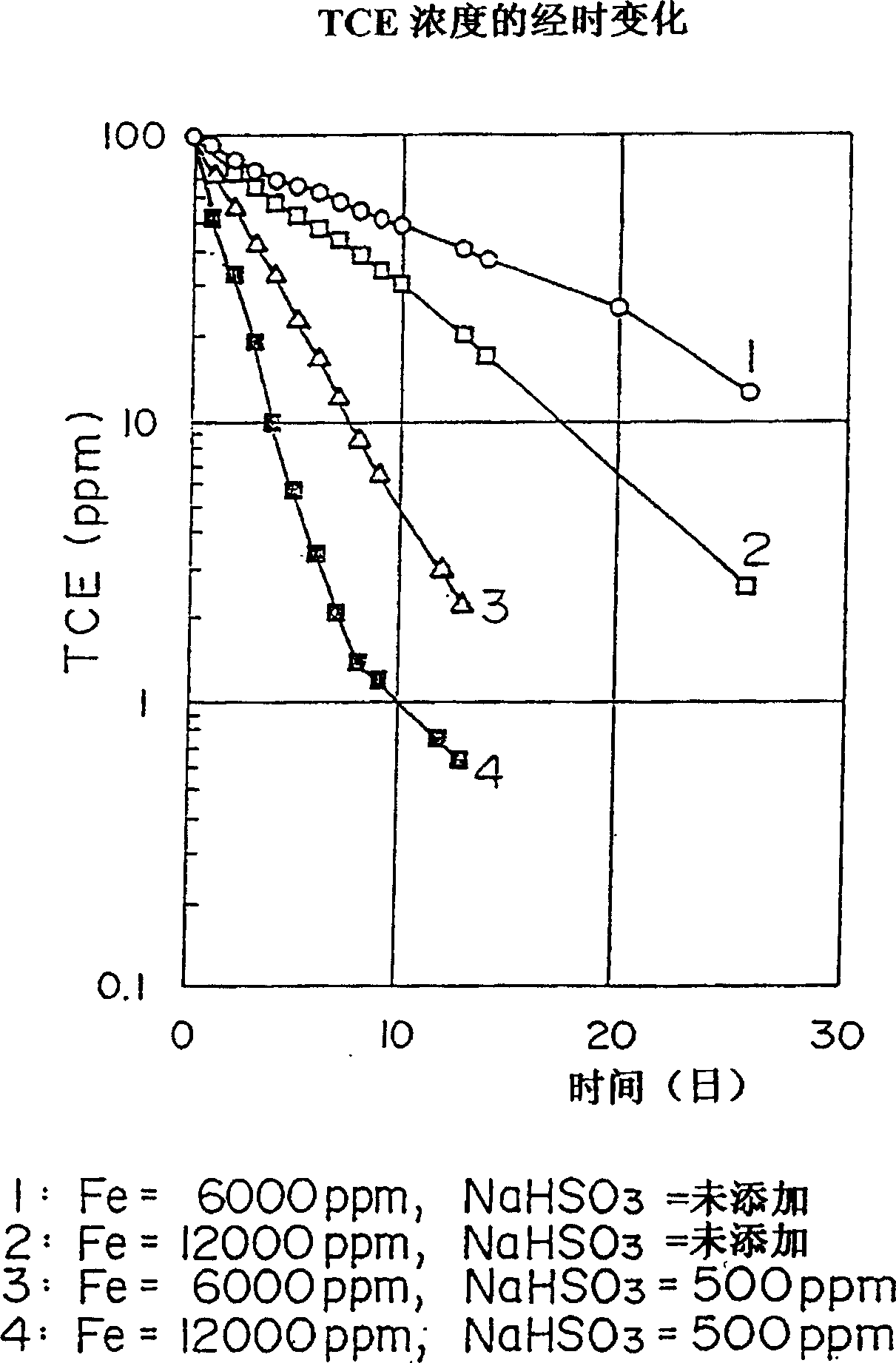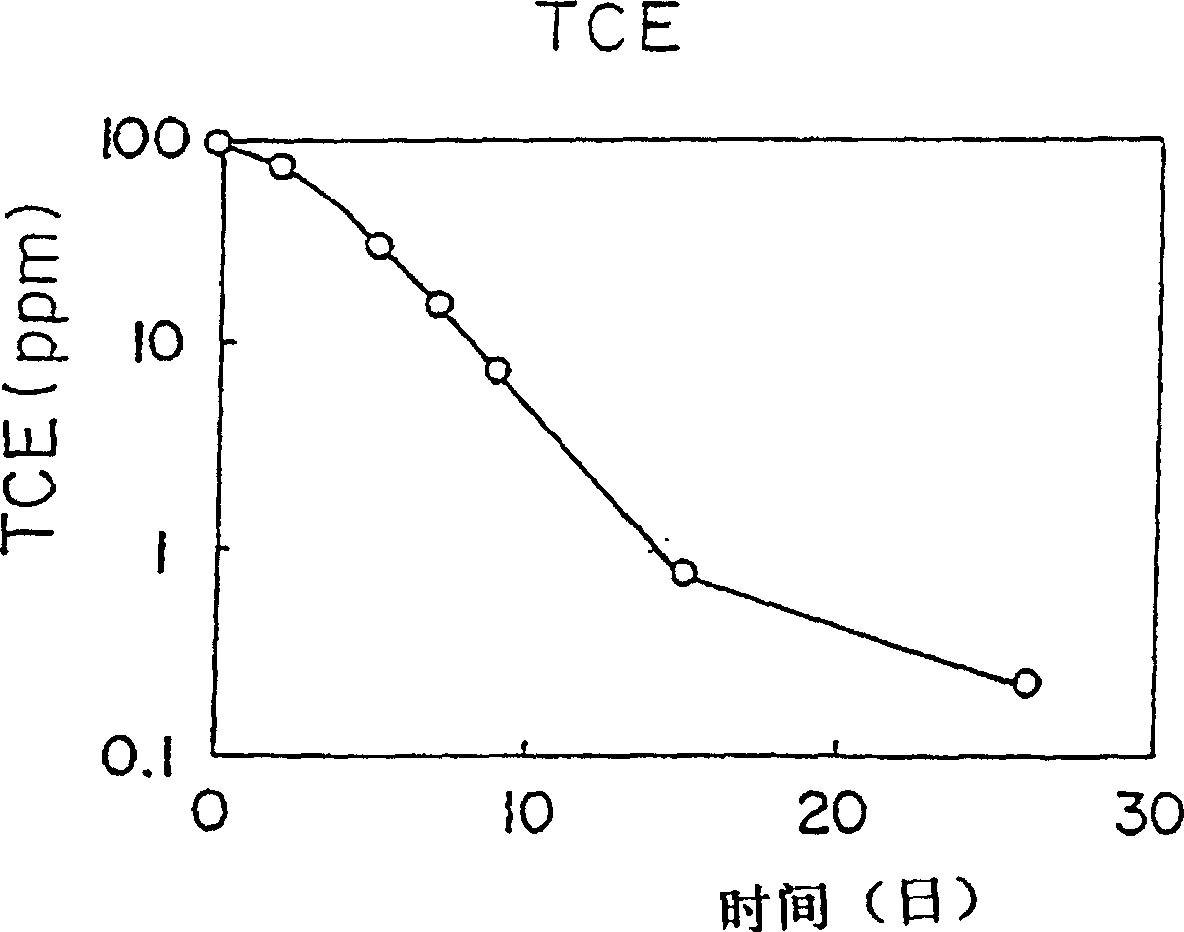Method for detoxification treatment of soil
A harmless treatment, soil technology, applied in the direction of energy wastewater treatment, restoration of polluted soil, etc., can solve the problems of slow response, soil function damage, failure to eliminate obstacles, etc.
- Summary
- Abstract
- Description
- Claims
- Application Information
AI Technical Summary
Problems solved by technology
Method used
Image
Examples
Embodiment 1
[0078] The decomposition of trichlorethylene in soil was investigated when the particle size of iron powder was changed.
[0079] Investigated the decomposition situation of trichlorethylene when adding and not adding iron powder in the soil, iron powder was used respectively when adding iron powder and was 0.2 weight %, and specific surface area was 2000 square centimeters / gram, and the addition amount was 0.2 weight % of soil, respectively More than 50% by weight of iron powder that can pass through a 300 micron sieve and more than 50% by weight of iron powder that can pass through a 150 micron sieve is added to the soil.
[0080] The results are shown in Table 1.
[0081] starting time
[0082] From these results, it can be seen that it is preferable to use 50% by weight or more of iron powder having a particle size that can pass through a 150 μm sieve.
Embodiment 2
[0084] The decomposition of trichlorethylene was investigated when the proportion of iron powder added to the soil was changed.
[0085] Investigated the decomposition status of trichlorethylene when adding and not adding iron powder in the soil, when adding iron powder, use carbon content 0.2% by weight, specific surface area 2000 square centimeters / gram, more than 50% by weight can pass through 150 micron sieve granularity, respectively It is added to the soil in proportions of 0.03 wt%, 0.1 wt% and 1.0 wt%.
[0086] The results are shown in Table 2.
[0087] starting time
[0088] It can be seen from the results that the addition ratio of iron powder in the soil is preferably at least 0.1% by weight, more preferably 0.2% by weight or more.
Embodiment 3
[0090] The decomposition of trichlorethylene with varying carbon content in iron powder was investigated.
[0091] Investigated the decomposition situation of trichlorethylene under the following conditions, iron powder uses specific surface area 2000 square centimeters / gram, and the addition ratio in soil is 0.2 weight %, and more than 50 weight % can pass through the iron powder of 150 micron sieve granularity, with respect to carbon Iron powders with contents of 0.005 wt%, 0.05 wt%, 0.1 wt% and 0.2 wt% were tested.
[0092] The results are shown in Table 3.
[0093] starting time
[0094] It can be seen from the results that the iron powder preferably has a carbon content greater than 0.1% by weight, and more preferably has a carbon content greater than 0.2% by weight.
PUM
 Login to View More
Login to View More Abstract
Description
Claims
Application Information
 Login to View More
Login to View More - R&D
- Intellectual Property
- Life Sciences
- Materials
- Tech Scout
- Unparalleled Data Quality
- Higher Quality Content
- 60% Fewer Hallucinations
Browse by: Latest US Patents, China's latest patents, Technical Efficacy Thesaurus, Application Domain, Technology Topic, Popular Technical Reports.
© 2025 PatSnap. All rights reserved.Legal|Privacy policy|Modern Slavery Act Transparency Statement|Sitemap|About US| Contact US: help@patsnap.com



